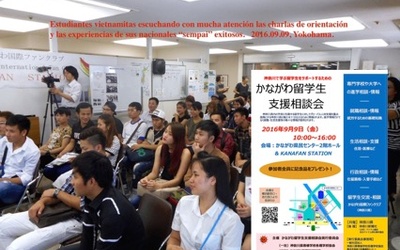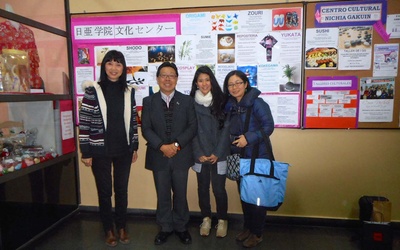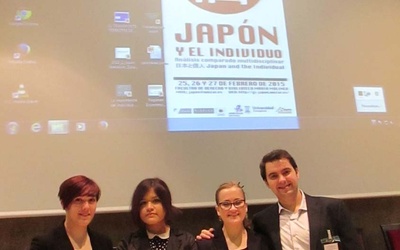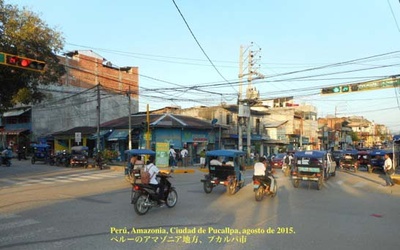
Alberto J. Matsumoto
@albertomatsumotoNisei Japanese-Argentine. In 1990, he came to Japan as a government-financed international student. He received a Master’s degree in Law from the Yokohama National University. In 1997, he established a translation company specialized in public relations and legal work. He was a court interpreter in district courts and family courts in Yokohama and Tokyo. He also works as a broadcast interpreter at NHK. He teaches the history of Japanese immigrants and the educational system in Japan to Nikkei trainees at JICA (Japan International Cooperation Agency). He also teaches Spanish at the University of Shizuoka and social economics and laws in Latin America at the Department of law at Dokkyo University. He gives lectures on multi-culturalism for foreign advisors. He has published books in Spanish on the themes of income tax and resident status. In Japanese, he has published “54 Chapters to Learn About Argentine” (Akashi Shoten), “Learn How to Speak Spanish in 30 Days” (Natsumesha) and others. http://www.ideamatsu.com
Updated June 2013
Stories from This Author
The momentum of international students from Asia is helping Japanese small and medium-sized enterprises expand overseas
March 3, 2017 • Alberto J. Matsumoto
Last September, I received a request from the Kanagawa International Foundation to participate as a lecturer in a seminar for Asian international students, even though I had been training Japanese-descended students from South America. I was surprised, but I was also curious to know more about Asian international students, so I gladly accepted. The project was organized in collaboration with a vocational school, a Japanese language school, and a Vietnam Association in Kanagawa Prefecture, and included presentations on the experiences …
Japanese Language Education in Japanese Communities in South America
Jan. 24, 2017 • Alberto J. Matsumoto
In my previous column , I pointed out that there are 4 million people studying Japanese in the world, but how many students are there in the Japanese community overseas? According to a 2012 report by the Japan Foundation, there are 443 Japanese language education institutions in South America with 1,652 instructors teaching 32,968 students. This is less than 1% of the world's learners. The number of Japanese students in South America is even smaller, and it can be estimated …
Japanese Language Education Abroad
Jan. 23, 2017 • Alberto J. Matsumoto
In recent years, the popularity of Japanese anime, manga and Japanese cuisine has led to an increase in the number of people studying Japanese overseas, which has in turn led to an increase in the number of foreigners coming to Japan. According to a survey conducted by the Japan Foundation in 20121, there are approximately 4 million people around the world studying Japanese language under 63,000 teachers at 16,000 institutions. Over the past 30 years, the number of learners has …
The pension situation in South America and pension issues for South American workers in Japan
Nov. 23, 2016 • Alberto J. Matsumoto
In recent years, consultations for foreigners at consultation desks have been increasing regarding pensions, nursing care, and retirement. As of December 2015, there are 230,000 foreigners from South America residing in Japan, including 170,000 Brazilians, 47,000 Peruvians, 5,400 Bolivians, and 2,600 Argentines. By age, those aged 60 or older make up 10% or less of the total, so it is not likely that many South Americans will be faced with pension or nursing care issues right away. However, with almost …
Latin America's low savings rate: is Japan's also quite low? -What is the savings rate of Japanese South American worker households in Japan?-
Oct. 10, 2016 • Alberto J. Matsumoto
Since around 2000, Latin American countries have been attracting attention for their high economic growth rates, and the consumer market of the new middle class has become the focus of global attention. International prices of primary products such as oil, mineral resources, and grains have soared, and many countries (Brazil, Mexico, Argentina, Bolivia, Venezuela, Chile, Uruguay, Paraguay, Peru, Ecuador, Colombia, etc.) have had good finances and implemented comprehensive social policies, leading to the belief that they would finally be able …
The connection between the next generation of Japanese descendants and Japan: Changes in Japanese societies in Latin America
Sept. 30, 2016 • Alberto J. Matsumoto
What kind of Nikkei are the "next generation of Nikkei1 "? Are they simply the descendants of Japanese who emigrated to Latin America - third, fourth, fifth generation, etc. (including not only Japanese, but also people of other races and ethnicities such as half and quota2 )? Or are they the "millennials" generation of Nikkei who have moved away from Japaneseness, young people who are free of ties, have a weak sense of belonging, are flexible, like new things, and …
Is the principle of equal pay for equal work difficult to apply to foreign workers?
July 25, 2016 • Alberto J. Matsumoto
At the end of January this year, the government announced its intention to take steps to realize equal pay for equal work as part of the "Japan Plan for a Society of 100 Million Active Parties." The government's intention is to correct the wage disparity that exists between regular and non-regular employment and to improve the income of non-regular workers, but it goes without saying that there are pros and cons to this argument.1 Around the same time, I came …
The economic relationship between Latin America and Japan that Japanese people don't know about
May 18, 2016 • Alberto J. Matsumoto
Latin America is home to the world's largest Japanese community, numbering 1.65 million. Meanwhile, in Japan, a Japanese community of 240,000 South American people is forming as Japanese workers who immigrated there since the 1990s have settled there. Japanese people are Japanese immigrants before and after the war and their descendants, but now there are more families with non-Japanese spouses, and the community is becoming quite diverse. Japanese people are often connected to Japan through the Japanese language and culture, …
Japanese descendants in Japan and South America: The challenges of managing organizations for young people and the new generation
April 13, 2016 • Alberto J. Matsumoto
Whenever I visit South American countries, I am always looked after by various Japanese organizations and exchange opinions with the executives involved in their operations. In countries that are thriving from economic growth, the Japanese community also appears to be doing quite well. On the other hand, here in Japan, Japanese South Americans who have settled there have established many national-level organizations, but most of them disappear before they are recognized by Japanese society. When an organization is established, it …
Poverty Rate in Japan and Permanent Foreign Residents
March 30, 2016 • Alberto J. Matsumoto
Recently, several Japanese print media outlets and blogs have featured articles on the poverty problem in Japan.1 According to analyses by experts and data compiled by aid organizations and research groups, the relative poverty rate in Japan, in other words, the proportion of people living below half the median per capita income, is one in six, giving the poverty rate at 16.1 %. Comparing the poverty rates of 30 OECD member countries, Japan ranks fourth with a high poverty rate, …















